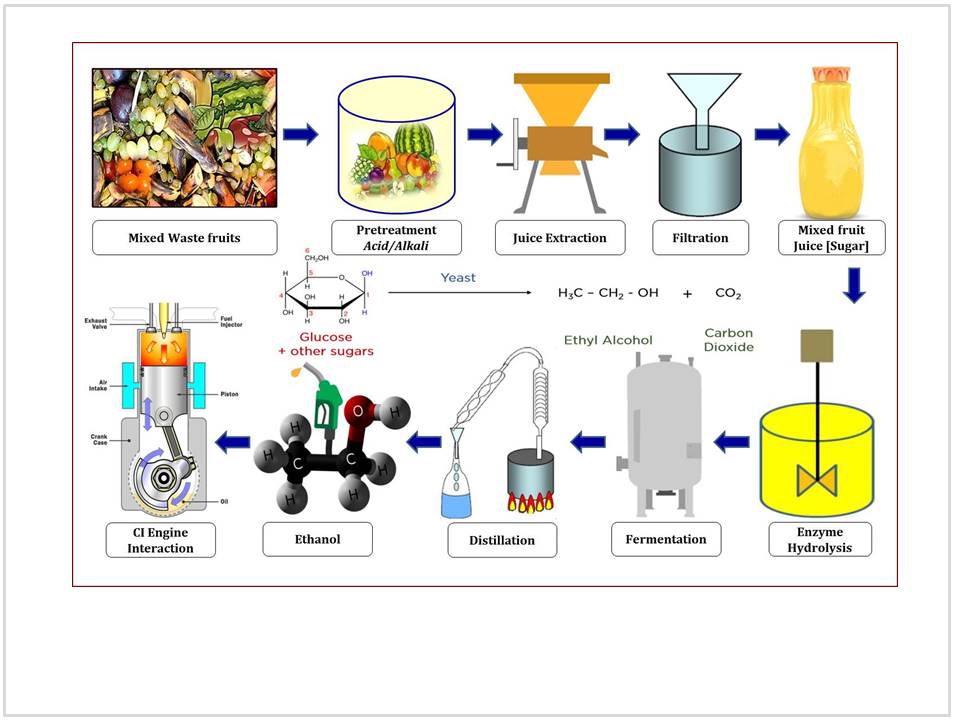Chemical Science & Engineering Research
Title
Bio-Chemical Characterization of Fruit Wastes as an Alternative Feedstock for Bio-Ethanol Production and Performance Analysis with a Diesel Engine System using Gasoline and Ethanol Blends
Authors
Panduranga Murthy G.* and Rajesh Kumar
University Department of Chemistry, Ranchi University, Ranchi - 834 001, India.
*Corresponding author E-mail address: drgpmurthy2467@gmail.com (Panduranga Murthy G.)
Article History
Publication details: Received: 02nd May 2022; Revised: 25th May 2022; Accepted: 25th May 2022; Published: 08th June 2022
Cite this article
Panduranga Murthy G.; Kumar R. Bio-Chemical Characterization of Fruit Wastes as an Alternative Feedstock for Bio-Ethanol Production and Performance Analysis with a Diesel Engine System using Gasoline and Ethanol Blends. Chem. Sci. Eng. Res., 2022, 4(10), 31-45.

Abstract
The bio-ethanol derived from sustainable waste material has become most important in recent times as the world researches to find an alternative energy as a convincing supplement for fossil fuels. In addition, the possible exploration of waste fruit biomass being generated ceaselessly at the local markets is not only emerging as viable and clean bio-fuel, it is also promoting the reduction of atmospheric pollution and global warming. The current investigation was undertaken to evaluate the sustainable and techno-economic feasibility of utilizing different categories of waste fruits for the production of bio-ethanol by employing a cost effective simple approach called yeast (Saccharomyces cerevisiae) fermentation technology. After performing the successful fermentation processes, the bioethanol production shown that, 730 μg/ml; 640 μg/ml; 510 μg/ml; 470 μg/ml; 460 μg/ml and 420 μg/ml of ethanol from 100 mL of waste fruit juices covering of Grape, Banana, Orange, Papaya and Sweet Lime and watermelon respectively. The ethanol production has been accomplished after distillation and maintaining a pH of 5.5 and a temperature of 30°C. Interestingly, the mixed waste fruit samples was showed substantially superior yield of bio ethanol (590 μg/ml) as compared to individual class of waste fruit samples where the physio-morphological analysis was very complex compared to mixed fruit approach. In all, the significant bio-ethanol recovery was noticed at mixed waste fruit samples (10.95%) under the yeast concentration of 2 g/L with the temperature of 30°C. whereas, the individual category of waste fruit samples i.e., grape fruits (11.35%) followed by watermelon (11.10%), pineapple (9.75%) and mango (8.65%) respectively. In the methodical experimentation, the increased ethanol production with increase in fermentation time until five days of incubation was recorded, where the glucose and pH were reduced during the fermentation process. The produced ethanol displayed extreme purity using GC-MS technique in comparison with the standard. In the meantime, the analysis of elemental composition (Al, Cu, Pb, Ca and Mg) of the mixed waste fruit sample was substantial and the viscosity, specific gravity, flash point, fire point and acid values of bioethanol were found to be within the limit of American Society for Testing and Materials (ASTM) standard specifications with less hazardous elements. Further, in the engine interactions, the bio-ethanol blends of WFBE5, WFBE10 and WFBE20 revealed that, the TFC with BMEP followed by BSFC with BMEP, BTE with BMEP at an engine speed of 2000 rpm were found to be excellent. This may possibly be significant in their expressions and found to be superior by increasing the compression ratio which could be accommodated for bio-ethanol blends since ethanol has a higher octane number rather than gasoline. In addition, at the peak of BMEP, the effect of bio-ethanol content on the volumetric efficiency was found to be more prominent for the WFBE10 blend. Later, the equivalence ratio of WFBE0 (100% gasoline only) was placed within lean limits at the lowest BMEP. The increased BMEP has a tendency of the mixture attaining at stoichiometric strength on the peak of BMEP. Furthermore, the engine-fuel interaction relating to emission parameters like, hydrocarbon, NO, CO and CO2 content were considerably lower in WFBE5 (5% bio-ethanol- with 95% gasoline), WFBE10 (10% bio-ethanol with 90% gasoline) and WFBE20 (20% bio-ethanol with 80% gasoline) than in WFBE0 (100% gasoline) having less fuel consumption. The generated results in due course confirmed that production of bio-ethanol can be achieved from waste fruits (both individually and mixed fruits) and possibly standardized as it is extremely sustainable and also renewable sources. The WFBE fuel can be used in the existing engine system in combination with pure petro-fuel by way of an eco-friendly approach with no release of toxic gases to the environment. Besides, the reduced fuel consumption can be monitored by using this most promising ethanol practice resulting from the waste fruit feedstock apart from environmental waste management.
Keywords
Bio-Ethanol production; Fermentation Technology; waste fruit samples; Saccharomyces cerevisiae (Yeast); Engine-fuel interaction & Performance analysis